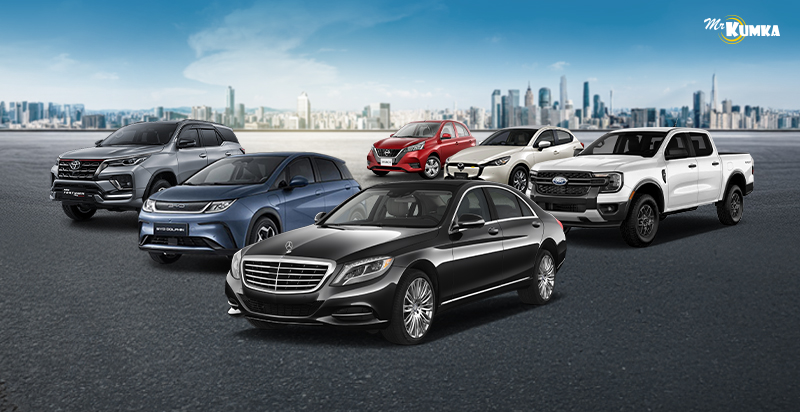
Understand how your vehicle category impacts your premiums
In Thailand, car insurance premiums are calculated based on the vehicle group defined by the OIC (Office of Insurance Commission). These groups, often referred to in group insurance assessments for cars in Thailand, are divided into group 1-5. Understanding your car’s group helps you choose the most suitable and cost-effective insurance coverage.
The office of insurance commission (OIC) categorises cars into 5 main groups based on origin, engine size, assembly method, vehicle type, and the market average price. These groups influence insurance premiums and underwriting. See which group your car belongs to:
This category includes vehicles that are 100% imported and assembled in overseas factories, primarily in Europe and the United States. These cars tend to be expensive, with high repair costs and limited availability of spare parts. Despite the premium price, European models in this group remain popular among drivers seeking luxury, superior performance, and long-term reliability.
These vehicles are European and American models imported as parts and assembled locally in Thailand, known as CKD (Completely Knocked Down). This method significantly reduces the cost compared to fully imported cars (CBU – Completely Built-Up). Although assembled domestically, they still maintain European manufacturing standards and advanced technology. As a result, European cars assembled in Thailand are highly popular, offering premium quality at a more affordable price point.
The car group 3 includes large Asian vehicles with engine capacities over 1,800cc, covering a wide range of models such as mid-to-full-size sedans, SUVs, 4-door pickup trucks, and MPVs. These cars are ideal for drivers who need strong engine performance for long-distance travel or navigating diverse road conditions. Their size and power make them a practical choice for both families and professionals.
This vehicle grouping features Asian car brands with engine sizes between 1,600 and 1,800cc. Vehicles in the car group 4 are highly popular among drivers seeking a well-balanced combination of size, performance, and fuel efficiency. Ideal for city driving, long-distance travel, and small to medium-sized families.
The car group 5 includes compact Asian vehicles with engine sizes below 1,500cc. While they are highly popular due to their affordability, fuel efficiency, and suitability for city driving, they are also considered higher risk. These cars are frequently involved in accidents, partly due to their widespread use, especially in urban areas where minor collisions are more common. Additionally, many drivers in this segment are younger or less experienced, which can contribute to increased accident rates.
In Thailand, car code 110 refers to a private sedan or passenger car with up to 7 seats, used solely for personal transportation and not for hire. In contrast, car code 120 applies to similar vehicles, also with a maximum of 7 seats, but used for commercial purposes, such as taxis, rental cars, or other services for hire. In short, code 110 is for personal use, while code 120 is for commercial or rental use.

In addition to OIC classifications, cars can also be grouped by usage, technology, or design, such as luxury car group, SUVs car group, or electric vehicle (EV) group. These categories may span multiple OIC groups but offer useful guidance when selecting insurance coverage.
The luxury car group includes high-end vehicles typically priced above THB 1,500,000, such as BMW, Mercedes-Benz, and Porsche. These cars fall under OIC group 1 and 2 due to their value and require specialised insurance coverage to ensure genuine parts and service standards.
The SUV car group includes sport utility vehicles across various price segments, from compact crossovers to large 4WD models. SUVs like the Toyota Fortuner and Mazda CX‑5 may fall into different OIC groups depending on their value, making it essential to check their classification for accurate coverage.
The electric vehicle (EV) group includes fully battery-powered cars such as the Tesla Model 3 and BYD Atto 3. While pricing determines their group under OIC rules, EVs have specific EV insurance needs like battery protection and specialised repair - making it important to choose a policy that’s tailored to electric vehicles.

Car groups play a crucial role in how insurance companies assess risk, determine premiums, and define coverage terms. Whether your vehicle falls under the standard OIC groups (1–5) or a lifestyle-based category like SUV or EV, these classifications can significantly impact the cost and conditions of your car insurance policy.

If you own a car in Thailand, knowing its insurance group can help you understand your premium and coverage options before purchasing a policy. These are our recommendations to help you identify your car group:
Your car’s make, model, engine size, and year of manufacture often determine its group. You can find these details on your vehicle registration book or from your dealership.
The OIC publishes a detailed list of car groups in Thailand, showing which models fall under each category. This can be accessed through their website.
Insurance companies in Thailand use the OIC classification to set premiums. Your provider can confirm your exact group and explain how it affects your coverage and costs.

Tips: If you plan to switch vehicles, check the new car’s group before buying. Choosing a lower group could significantly reduce your insurance premium.
